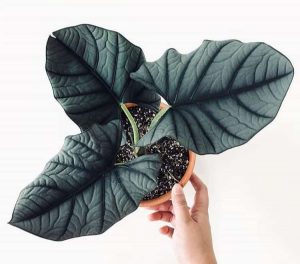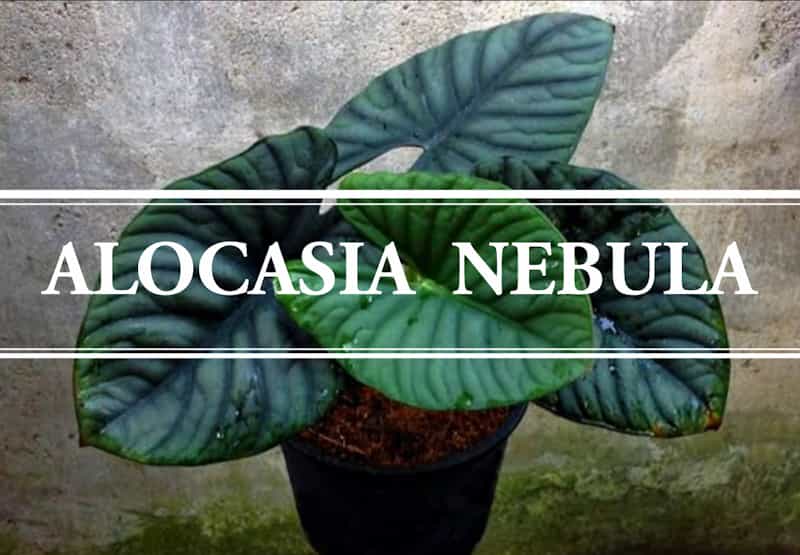Mirror Mirror on the wall! Which is the prettiest Alocasia of all?? You must be aware of the mesmerizing foliage of the jewel Alocasias. The beauty of these tropical aroids has been ornamenting our surroundings for ages. We are going to introduce the most beautiful Jewel Alocasia, the Alocasia nebula.
The green heart-shaped leaves mature to get a silvery grey shade with patterned venation in dark grey to charcoal. The uniquely silvery shade of these thick leaves is enough to give an exotic look to this plant. These plants make prominent terrestrial potted plants for indoor decoration. Interesting? Let us share the classification, propagation, and care of this attractive beauty, the high-maintenance Alocasia Silver nebula plant.
Alocasia Nebula Classification and History
Classification
Family: Araceae.
Genus: Alocasia.
Species: A. nebula
History
This plant lived a life in doom and was merely known as a species in alocasian family. At last, in 1998, Alistair Hay revised the true identity of the plant. David Brunette also mentioned the plant in the Australian monograph, ‘The cultivated Alocasia’. It was the year 2000 when a formal name was finally given to the plant. According to a school of thought, this plant had tissue culture development and propagation protocols. Moreover, they were marketed on the internet by the horticulture society, way before they were named officially.
Genus Alocasia
The genus Alocasia comprises more than 79 perennial flowering plant species. These natives of the Asian and Australian rainforests are commonly associated with under mentioned names:
- The ‘African Masks’
- The ‘Elephant-ear plants’.
These names refer to the specific leaf shape.
The prominent features of the genus include broad-leafed foliage and a rhizomatous root system. A large number of new and unique plants are produced by extensive hybridization and cultivation.
Other Names of Alocasia Nebula
- The plant was formerly considered as a variety of the Alocasia Guttata plant and known as Alocasia guttata var. imperialis.
- The Silver Plant.
- Alocasia Silver Nebula.
- The elephant ear plant (the common name of the genus).
Alocasia Nebula Plant Features

Height and Structure
- The height of a mature plant ranges between 70 to 90 cm.
- The plant grows as a terrestrial shrubby plant.
Leaves
- The length of a mature leaf is around 45 cm with a width of 25 cm.
- Each heart-shaped leaf grows on an erect to erector-spreading petiole with a lamina joined at a downward angle.
Flowers
The plant flowers by typical Anthurium-like insignificant flowers.
Toxicity
Just like other Alocaisans, this plant is highly toxic and owns level 4 toxicity. Ingestion may lead to allergic reactions to the skin and eyes. Thus, it is important to keep your kids and pets away from these plants.
Dormancy
People, who are not familiar with the phenomena of the dormancy of Alocasian plants, usually get worried. They consider that the plant has died because of the fierce winter. However, the plant usually sheds some or all of the leaves with stunted growth. This is known as the ‘sleeping’ or the ‘dormant’ stage. You will see the plant start flourishing again, as soon as the spring arises.
Alocasia Nebula Cultivars Varieties and Cultivars
This plant is hybridized and cultivated widely to create a number of new plants.
- Alocasia nebula ‘imperialis’.
- Alocasia nebula ‘Balun’.
- A. nebula ‘Elaine’.
Alocasia Nebula Care
This is one of the most difficult Alocasias to grow. We never recommend it for beginners. Let us have a look at the requirements of the Alocasia Silver Nebula plant.
Water Requirement
The plant needs partially moist soil. This is an important and crucial part of the care of this plant. You need to maintain a balance between keeping the soil semi-moist and semi-dry. Water the plant moderately and wait for the soil to drain and get semi-wet before you water again. As the estimated schedule is to water the plant about thrice a week in summer. Moreover, reduce the watering in winter to about once or twice a week.
It is important to mention here that overwatering, soggy soil and wet feet are unsuitable for the plant. This may lead to health issues like root rot.
Sunlight Requirement
This plant needs bright indirect sunlight. Additionally, they can do well in partial shades and artificial light as well. Make sure you keep the plant away from direct light. As the fierce sun will burn the delicate leaves.
Temperature Requirement
Alocasia usually likes warm environments. The optimal temperature range is between 18 to 25 °C.
These plants are not wintered hardy. A constant temperature below 17 °C will make the plant get dormant.
Soil Requirement
An organic, well-drained soil with good aeration and a good proportion of peat moss is an ideal growing medium. In addition, you can add some perlite in case the available soil seems heavier.
Humidity Requirement
Just like other Alocasians, the Nebulas are humidity lovers. Ideally, there should be at least 65% moisture in the air. The measures to maintain an adequate humidity level include adding a humidifier or a pebble-water tray under the pot. Moreover, grouping the Alocasia with other plants is another good option.
Fertilizer Requirement
Use a diluted form of domestic plant fertilizer once a month in spring and summer. These plants can’t digest the additional nutrition in winter.
Pot Requirement
The plants do well in small-sized pots with drainage holes. This will be suitable to keep them root bound with good drainage.
Repotting Requirement
Repotting is not required unless you see roots getting congested or coming out of the drainage holes.
Pruning Requirement
Pruning is necessary to maintain the appearance of almost all the Alocasians. Remove the yellow, brown, or unhealthy leaves as soon as possible. This may help to control any fungus or unhealthy foliage as soon as it starts.
Alocasia Nebula Propagation
Just like other Alocasias, the plant can be propagated by the division of underground rhizome.
Season
The ideal time for propagation is spring and summer.
- Loose the soil around a healthy mature plant and take it out softly.
- Use a sharp knife to cut about 1/3rd of the rhizome.
- Plant the baby rhizome in a moist substrate. Don’t forget to plant the parent back rhizome.
- Place the pot in a warm and humid place with partial shade. Make sure direct light does not reach the plant at this stage.
Growth Timeline
We usually share an estimated growth pattern and the specific plant requirements at that stage. We hope this is helpful for you to get an idea about the initial requirements and growth process of the plant.
Day 1 to Day 30: Just mist the soil frequently. Once the soil gets about 60% dry, you need to water again. Place the pot in a warm place with good humidity and indirect light. Importantly, avoid overwatering, as soggy soil can make the plant rot directly. Tiny roots begin to develop after the end of the first three weeks.
Day 30 to Day 90: Tiny shoot usually grows out after the 4th week. No changes in care are required up till now.
Day 90 Onwards: The newly planted rhizome is finally a baby plant. Just follow the Alocasia nebula Care already shared in the previous section.
Congratulations! Finally, you can enjoy the new Nebula Jewel Alocasia.
Problems of The Alocasia Nebula Plant
The Common problems faced by the Alocasia Silver nebula include;
- Aphids.
- Mealybugs.
- Scales.
- Spider mites.
Solutions
Some experts recommend cleaning the foliage with warm soapy water, once a month. This will prevent the above-mentioned pests away. Moreover, it will clean the leaves as well. Common houseplant pests and their eggs can be controlled by commercial insecticides.
Domestic remedies include squishing and pressure washing the insects like mealy bugs. Make sure you don’t let the residual water reach the soil or the neighbouring plants.
Related Posts:
Summary
The Alocasia nebula is one of the most beautiful and difficult to care for Jewel Alocasia. The thick, heart-shaped leaves are greyish in color with reddish undersides. The care includes frequent watering and moist warm places with bright indirect light. In addition, these highly toxic plants need to keep out of the reach of kids and pets.

